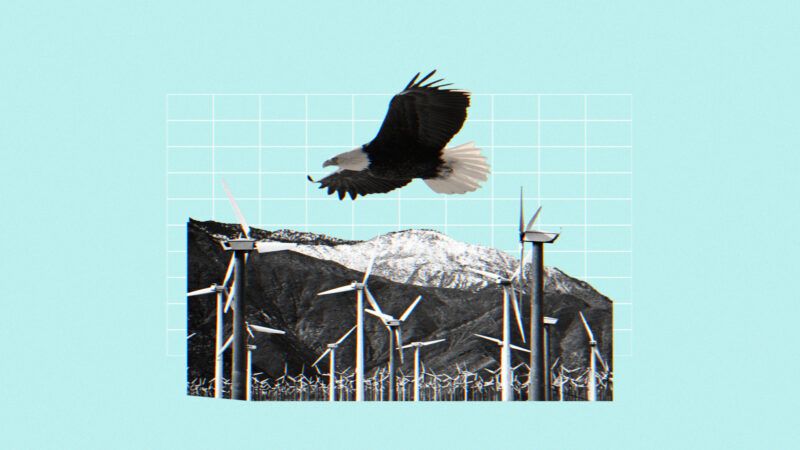The Case for Tradeable Permits in Dead Birds
A push toward wind energy threatens to kill more eagles. Markets can help.

Many politicians and conservationists have high hopes of replacing fossil fuels with clean energy, but from a bird's eye view, wind turbine blades are deadly. The U.S. Fish and Wildlife Service estimates that wind turbines kill almost 328,000 birds each year.
Earlier this year, one of the largest renewable energy companies in the country was fined $8 million for unintentionally killing 150 bald and golden eagles at wind farms in eight states over recent years. But, if the company had held a permit from the service, it would not have been penalized. A smarter, market-based permitting approach could motivate wind developers to conserve eagles even as the sector expands.
Eagles are protected by federal law, but wind developers can apply for permits that allow them to kill up to a certain number of the birds "incidentally" in the course of generating wind power. (Any deaths of golden eagles, which number far fewer than bald eagles, require permittees to take actions to help boost their population.)
The problem with the current permitting system, however, is that it does too little to encourage conservation. As long as wind companies stay under their individual caps, a project that kills five eagles a year might be treated the same as one that kills 50.
Instead of a blunt, one-size-fits-all framework, making permits tradeable would encourage wind generators to conserve eagles regardless of their current impacts. Harnessing markets would motivate wind companies—and perhaps other industries—to avoid killing eagles while still allowing for the growth of the sector, an aim for the Biden administration and power companies alike.
When it comes to improving environmental quality, tradeable permits have proven to be much better than inflexible standards. The problem with standards-based approaches is that they treat all polluters the same, regardless of the costs they face or the benefits they produce for society. Limiting each factory to a certain amount of air pollution, for instance, can keep overall pollution under a total cap, but it doesn't encourage any factory to discover cleaner processes that would slash its emissions to, say, half its own limit.
Tradeable permits offer that incentive because a factory that figures out how to cut its own emissions could sell its excess permits to another one, which might be planning to increase production. Overall pollution stays the same—or even falls—even as society reaps more benefits. In the U.S., approaches that harness trade and markets have helped clean the air much more cheaply and phase lead out of gasoline much more quickly than we otherwise would have.
A recent report from the Property and Environment Research Center (PERC), where I work, outlines how the same principles can be applied to conserving eagles. Biologists at the Fish and Wildlife Service could still set an overall cap for incidental eagle deaths that ensures the populations remain strong. But each wind project could trade its permits, giving every one of them an incentive to kill fewer eagles.
Some wind farms are in areas where eagles are at high risk of colliding with a turbine. These wind farms might expect to kill more eagles than their caps allow, while others, in less risky areas, would anticipate staying under their limits. An eagle kill avoided would result in an unneeded permit, which could be sold—perhaps to an operator that intends to expand production.
Every wind farm would bear the cost of killing any additional eagle, motivating them to operate more safely, innovate lower-impact designs, or consider different sites for future projects.
A tradeable permit system could also be expanded to include other industries, such as transmission line operators. Electrocution is already a significant threat to eagles, responsible for half of golden eagle deaths according to one study, so including line operators would be common sense. Tradeable permits would give every power line operator a reason to reduce risks to eagles, whether by insulating lines, altering pole placement, or taking other measures.
The recovery of our national bird is a huge success story. After pesticide use and other factors plummeted bald eagle numbers to near extinction in the 1960s, environmental policies and conservation efforts set the species on the course for a huge rebound. Today, the lower 48 states are home to more than 300,000 bald eagles.
Many have high hopes for wind energy over the coming decades, but it doesn't have to come at the cost of avian conservation. A revamped permitting system that harnesses trade would allow for future growth of the sector while conserving iconic eagles.


Show Comments (44)